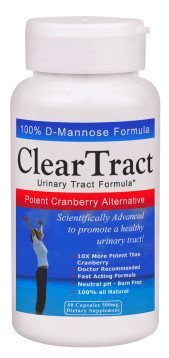|
|
 |
|
D-Mannose is a compound in the sugar family. It is found
in some plants, trees and foods. It is also naturally occurring
in human metabolism, so it is not foreign substance to the body.
Foreign and synthetic substances like pharmaceuticals
often have a long list of side effects.
Urinary Tract Infections
Most Bladder Infections are
caused by the bacteria called Escherichia coli that contain
tiny projections that glue it to the lining of the urinary
tract. That is why urination does not remove the bacteria
and infection occurs. Now there is a new product that
these bacteria are highly attracted to, In fact they would
rather bind to this substance than the lining of the urinary
tract. When the proper dose is taken the bacteria promptly
detach from the urinary tract lining and bind to this
substance. Now the freely floating bacteria attached to
this substance is then eliminated upon urination flushing
the infection away. ClearTract can be very effective,
especially in those who experience chronic problems, and
it doesn't have the side-effects or other problems associated
with antibiotics.
New Solution for Common Bladder Infections
Conventional doctors typically have used antibiotics to
treat cystitis. However, doctors are having an increasingly
unsuccessful time treating them with antibiotics, most
likely due to antibiotic resistance and the fact than
only a few of the commonly used antibiotics achieve adequate
levels in the urinary tract to be effective.
Bladder infections have long baffled doctors -- and agonized
patients -- with their resiliency. A strong dose of antibiotics
can bring relief, but the painful infection often returns
in as little as a few days.
What is Happening here
?
In a report published recently
researchers at Washington University School of Medicine
in St. Louis explain why bladder infections are so hard
to beat. It turns out that E. coli, the most abundant
bacterium in the human body and the cause of most bladder
infections, can dodge antibiotics by invading the immune-system
cells that line the wall of the bladder.
"Before this study, nobody knew that E. coli could
live inside immune-system cells, " says David M.
Baorto, M.D., Ph.D., fellow in laboratory medicine at
the School of Medicine and lead author of the study. "They
apparently can take shelter in the very cells that usually
destroy them."
About half of American women experience bladder infections
at least once during their lifetime, and up to 10 percent
suffer three to five infections per year. Antibiotics
used to treat these infections may have little effect
against bacteria that are hiding in other cells, says
co-researcher Soman Abraham, Ph.D., assistant professor
of pathology and of molecular microbiology.
E. coli usually lives harmlessly in the intestines, but
female anatomy makes it easy for the bacterium to get
swept into the urinary tract. Once there, the bugs use
sticky, hair-like structures called pili to cling to the
walls of the urethra and bladder, without this strong
adhesion the bacteria can't cling and colonize because
the environment is constantly flushed with urine.
Other Problems with antibiotic treatment
Antibiotics suppress the immune system and increase the
likelihood of recurrence of infections. Every woman is
also familiar with "yeast infections" that follow
antibiotic use, as the "friendly bacteria" are
killed off along with the "bad bacteria", leaving
the antibiotic insensitive yeast to grow "out of
control". Long term or often repeated antibiotic
use can lead to major disruptions in normal body microflora,
and sometimes to major disruptions in health, especially
immune system function.
There is Hope !
For these reasons antibiotics are not always the best
treatment choice. A new product called ClearTract
contains D-Mannose can be faster and more effective, especially
in dealing with chronic problems, and it doesn't have
the side-effects or other problems associated with antibiotics.
E.coli contains tiny projections from the cell wall that
have a glycoprotein, called a lectin, that "glues"
it to the lining of the urinary tract. That is why urination
does not remove the bacteria. D-Mannose readily binds to these
lectin and However E.coli are highly
attracted to the D-Mannose much more than the lining of
the urinary tract. When the proper dose of ClearTract
is taken the E.coli bacteria promptly detach from the
urinary tract lining and bind to the D-Mannose. Now the
freely floating bacteria attached to the D-Mannose is
then eliminated upon urination.
In the June 1999 edition of Nutrition & Healing, Jonathan
V. Wright, M.D cites three patient cases in which D-mannose
quickly eliminated recurring episodes of cystitis that
had not responded to antibiotics.
Unlike antibiotics, D-Mannose is safe, even long term.
Which makes it ideal for people who have chronic cases
that would be difficult to take antibiotics long term.
In addition, D-Mannose has no side-effects. It doesn't
kill friendly bacteria, and it is much cheaper than antibiotics.
Also the Ecoli bacteria don't become resistant to it.
What is D-Mannose ?
The ingredients are 100% D-Mannose, which is a rare saccharide
that is naturally occurring in some plant and food substances
and even produced in the body. It has no toxicity and
is not a drug, it is a nutritional food substance. It
is safe, and all natural. Since it isn't metabolized it
doesn't interfere with blood sugar regulation, even for
diabetics. It creates no disruption or imbalance in normal
body microflora, so one wouldn't be more prone to yeast
infections as is often the case after a course of antibiotics.
It's safe even for pregnant women and very small children.
Need ClearTract Today ?
Find It Locally in

,
|

Our 60 capsule bottle of ClearTract
will be enough for most single episodes.
Your price only
$19.95

|
|
 |
|
© 2008 Discover Nutrition
All rights reserved.
|
|
|
